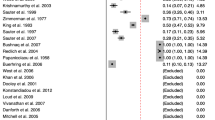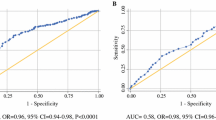Abstract
The presence of epithelial cells in breast nipple aspirate fluid (NAF), irrespective of abnormality, has been associated with increased risk of breast cancer in previous studies. We sought to investigate whether the presence of epithelial cells in NAF is associated with nutritional parameters among 71 healthy premenopausal women who participated in the Nutrition and Breast Health Study and provided any samples of NAF during the study. Total of 142 samples which were obtained over a 1-year period of intervention with low-fat and/or high vegetable-fruit diets were available for cytological evaluation. The odds ratios (ORs) and 95% confidence intervals (CIs) for the detection of epithelial cells in NAF were estimated by fitting generalized estimating equations models by quartile level of nutritional parameters. The probability of yielding epithelial cell-positive NAF progressively increased with increasing total fat intake (p=0.001). The OR for the highest quartile level of fat intake, compared with lowest, was 7.22 (95% CI 1.14–45.82). On the other hand, there were a marginally significant inverse association with total fiber intake as well as an weak inverse association with the number of servings of fruit and vegetables. Furthermore, the probability of detecting epithelial cells in NAF decreased with increasing plasma levels of lutein and α-carotene (p-values for linear trend; 0.001 and 0.049, respectively). The ORs for the highest versus lowest quartile levels are 0.17 (95% CI 0.04–0.65) and 0.19 (95% CI 0.04–0.91), respectively. These results are generally in support of roles of nutritional factors in breast cancer and thus further studies are warranted.
Similar content being viewed by others
References
Klein PM, Lawrence J, 2002 Lavage and nipple aspiration of breast ductal fluids: a source of biomarkers for environmental mutagenesis Environ Mol Mutagen 39: 127–133
Lee MM, Petrakis NL, Wrensch MR, King EB, Miike R, Sickles E, 1994 Association of abnormal nipple aspirate cytology and mammographic pattern and density Cancer Epidemiol Biomarkers Prev 3: 33–36
Sauter ER, Ross E, Daly M, Klein-Szanto A, Engstrom PF, Sorling A, Malick J, Ehya H, 1997 Nipple aspirate fluid: a promising non-invasive method to identify cellular markers of breast cancer risk Br J Cancer 76: 494–501
Wrensch MR, Petrakis NL, Miike R, King EB, Chew K, Neuhaus J, Lee MM, Rhys M, 2001 Breast cancer risk in women with abnormal cytology in nipple aspirates of breast fluid J Natl Cancer Inst 93:1791–1798
Yonekura Y, Yamamoto D, Okugawa H, Tanaka K, Kamiyama Y, 2005 Loss of heterozygosity in ductal lavage for breast tumor and the contralateral breast Oncol Rep 13:739–743
Evron E, Dooley WC, Umbricht CB, Rosenthal D, Sacchi N, Gabrielson E, Soito AB, Hung DT, Ljung B, Davidson NE, Sukumar S, 2001 Detection of breast cancer cells in ductal lavage fluid by methylation-specific PCR Lancet 357:1335–1336
King EB, Barrett D, King MC, Petrakis NL, 1975 Cellular composition of the nipple aspirate specimen of breast fluid. I. The benign cells Am J Clin Pathol 64:728–738
Boyd NF, Stone J, Vogt KN, Connelly BS, Martin LJ, Minkin S, 2003 Dietary fat and breast cancer risk revisited: a meta-analysis of the published literature Br J Cancer 89:1672–1685
Gandini S, Merzenich H, Robertson C, Boyle P, 2000 Meta-analysis of studies on breast cancer risk and diet: the role of fruit and vegetable consumption and the intake of associated micronutrients Eur J Cancer 36:636–646
Wu AH, Pike MC, Stram, 1999 DO: Meta-analysis dietary fat intake, serum estrogen levels, and the risk of breast cancer J Natl Cancer Inst 91:529–534
Fowke JH, Longcope C, Hebert J, 2000 Brassica vegetable consumption shifts estrogen metabolism in healthy postmenopausal women Cancer Epidemiol Biomarkers Prev 9: 773–779
Boyd NF, Greenberg C, Lockwood G, Little L, Martin L, Byng J, Yaffe M, Tritchler D, 1997 Effects at two years of a low-fat, high-carbohydrate diet on radiologic features of the breast: results from a randomized trial J Natl Cancer inst 89: 488–496
Chen G, Heilbrun LK, Venkatramanamoorthy R, Maranci V, Redd JN, Klurfeld DM, Djuric Z, 2004 Effects of low-fat and/or high-fruit-and-vegetable diets on plasma levels of 8-isoprostane-F2alpha in the Nutrition and Breast Health study Nutr Cancer 50: 155–160
Djuric Z, Poore KM, Depper JB, Uhley VE, Lababidi S, Covington C, Klurfeld DM, Simon MS, Kucuk O, Heilbrun LK, 2002 Methods to increase fruit and vegetable intake with and without a decrease in fat intake: compliance and effects on body weight in the nutrition and breast health study Nutr Cancer 43:141–151
Djuric Z, Visscher DW, Heilbrun LK, Chen G, Atkins M, Covington CY, 2005 Influence of lactation history on breast nipple aspirate fluid yields and fluid composition Breast J 11:92–99
Allison PD: Logit analysis of longitudinal and other clustered data. In: Logistic Regression Using the SAS System: Theory and Application. SAS Inst Inc, Cary, NC, 1999, pp 179–216
Giammarioli S, Filesi C, Sanzini E, 1999 Oxidative stress markers: specificity and measurement techniques Ann Is Super Sanita 35: 563–576
Chaldakov GN, Stankulov IS, Hristova M, Ghenev PI, 2003 Adipobiology of disease: adipokines and adipokine-targeted pharmacology Curr Pharm Des 9: 1023–1031
Wellen KE, Hotamisligil GS, 2005 Inflammation, stress, and diabetes J Clin Invest 115: 1111–1119
Iyengar P, Combs TP, Shah SJ, Gouon-Evans V, Pollard JW, Albanese C, Flanagan L, Tenniswood MP, Guha C, Lisanti MP, Pestell RG, Scherer PE, 2003 Adipocyte-secreted factors synergistically promote mammary tumorigenesis through induction of anti-apoptotic transcriptional programs and proto-oncogene stabilization Oncogene 22: 6408–6423
Boyd NF, Jensen HM, Cooke G, Han HL, Lockwood GA, Miller AB., 2000 Mammographic densities and the prevalence and incidence of histological types of benign breast disease Eur J Cancer Prev 9: 15–24
Sala E, Warren R, McCann J, Duffy S, Luben R, Day N, 2000 High-risk mammographic parenchymal patterns, hormone replacement therapy and other risk factors: a case–control study Int J Epidemiol 29: 629–636
Vachon CM, Kuni CC, Anderson K, Anderson VE, Sellers TA, 2000 Association of mammographic defined breast density with epidemiologic risk factors for breast cancer Cancer Causes Control 11: 653–662
Boyd NF, McGuire V, Fishell E, Kuriov V, Lockwood G, Tritchler D, 1989 Plasma lipids in premenopausal women with mammographic dysplasia Br J Cancer 59: 766–771
Boyd NF, Connelly P, Byng J, Yaffe M, Draper H, Little L, Jones D, Martin LJ, Lockwood G, Tritchler D, 1995 Plasma lipids, lipoproteins, and mammographic densities Cancer Epidemiol Biomarkers Prev 4: 727–733
Chlebowski RT, Blackburn GL, Elashoff RE, Thomson C, Goodman MT, Shapiro A, Giuliano AE, Karanja N, Hoy MK, Nixon DW, Investigators TW: Dietary fat reduction in postmenopausal women with primary breast cancer; Phase III Women’s Intervention Nutrition Study (WINS). Proceedings of the American Society of Clinical Oncology 2005,Vol. 10 2005
Lee MM, Wrensch MR, Miike R, Petrakis NL, 1992 The association of dietary fat with ability to obtain breast fluid by nipple aspiration Cancer Epidemiol Biomarkers Prev 1:277–280
Petrakis NL, Barnes S, King EB, Lowenstein J, Wiencke J, Lee MM, Miike R, Kirk M, Coward L, 1996 Stimulatory influence of soy protein isolate on breast secretion in pre- and postmenopausal women Cancer Epidemiol Biomarkers Prev 5:785–794
Mattisson I, Wirfalt E, Johansson U, Gullberg B, Olsson H, Berglund G, 2004 Intakes of plant foods, fibre and fat and risk of breast cancer – a prospective study in the Malmo Diet and Cancer cohort Br J Cancer 90:122–127
Howe GR, Hirohata T, Hislop TG, Iscovich JM, Yuan JM, Katsouyanni K, Lubin F, Marubini E, Modan B, Rohan T, Toniolo P, Shunzhang Y, 1990 Dietary factors and risk of breast cancer: combined analysis of 12 case–control studies J Natl Cancer Inst 82: 561–569
Holmes MD, Willett EC, 2004 Does diet affect breast cancer risk? Breast Cancer Res 6: 170–178
Micozzi MS, Carter CL, Albanes D, Taylor PR, Licitra LM, 1989 Bowel function and breast cancer in US women Am J Public Health 79:73–75
Petrakis NL, King EB, 1981 Cytological abnormalities in nipple aspirates of breast fluid from women with severe constipation Lancet 2:1203–1204
Toniolo P, Van Kappel AL, Akhmedkhanov A, Ferrari P, Kato I, Shore RE, Riboli E, 2001 Serum carotenoids and breast cancer Am J Epidemiol 153:1142–1147
Tamimi RM, Hankinson SE, Campos H, Spiegelman D, Zhang S, Colditz GA, Willett WC, Hunter DJ, 2005 Plasma carotenoids, retinol, and tocopherols and risk of breast cancer Am J Epidemiol 161: 153–60
Slattery ML, Benson J, Curtin K, Ma KN, Schaeffer D, Potter JD, 2000 Carotenoids and colon cancer Am J Clin Nutr 71: 575–582
Gruenke LD, Wrensch MR, Petrakis NL, Miike R, Ernster VL, Craig JC, 1987 Breast fluid cholesterol and cholesterol epoxides: relationship to breast cancer risk factors and other characteristics Cancer Res 47: 5483–5487
Ernster VL, Wrensch MR, Petrakis NL, King EB, Miike R, Murai J, Goodson WH 3rd, Siiteri PK, 1987 Benign and malignant breast disease: initial study results of serum and breast fluid analyses of endogenous estrogens J Natl Cancer Inst 79: 949–960
Hargreaves DF, Potten CS, Harding C, Shaw LE, Morton MS, Roberts SA, Howell A, Bundred NJ, 1999 Two-week dietary soy supplementation has an estrogenic effect on normal premenopausal breast J Clin Endocrinol Metab 84: 4017–4024
Chen G, Djuric Z, 2002 Detection of 2,6-cyclolycopene-1,5-diol in breast nipple aspirate fluids and plasma: a potential marker of oxidative stress Cancer Epidemiol Biomarkers Prev 11:1592–1596
Wrensch MR, Petrakis NL, Gruenke LD, Ernster VL, Miike R, King EB, Hauck WW, 1990 Factors associated with obtaining nipple aspirate fluid: analysis of 1428 women and literature review Breast Cancer Res Treat 15: 39–51
Kurian AW, Mills MA, Jaffee M, Sigal BM, Chun NM, Kingham KE, Collins LC, Nowels KW, Plevritis SK, Garber JE, Ford JM, Hartman AR, 2005Ductal lavage of fluid-yielding and non-fluid-yielding ducts in BRCA1 and BRCA2 mutation carriers and other women at high inherited breast cancer risk Cancer Epidemiol Biomarkers Prev 14:1082–1089
Acknowledgements
We thank all the women who participated in the Nutrition and Breast Health Study. Janice B. Depper and Kathleen M. Poore were dietitians for the study, and Dr Chandice Y. Covington helped to devise the NAF aspiration procedure. F. Hoffman-LaRoche Ltd., Basel, Switzerland generously provided the Tocol and lycopene HPLC standards. This study was supported by the US National Cancer Institute through research Grants U01CA77297 to Z. Djuric and CA93817 to I. Kato.
Author information
Authors and Affiliations
Corresponding author
Rights and permissions
About this article
Cite this article
Kato, I., Ren, J., Visscher, D.W. et al. Nutritional predictors for cellular nipple aspirate fluid: Nutrition and Breast Health Study. Breast Cancer Res Treat 97, 33–39 (2006). https://doi.org/10.1007/s10549-005-9084-9
Received:
Accepted:
Published:
Issue Date:
DOI: https://doi.org/10.1007/s10549-005-9084-9




